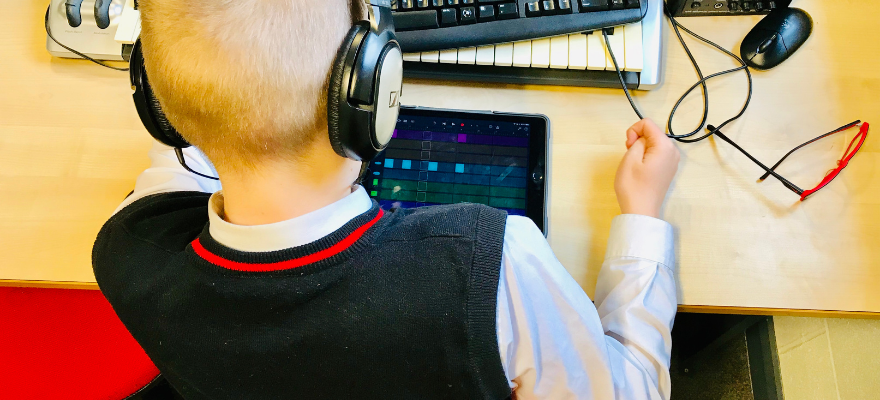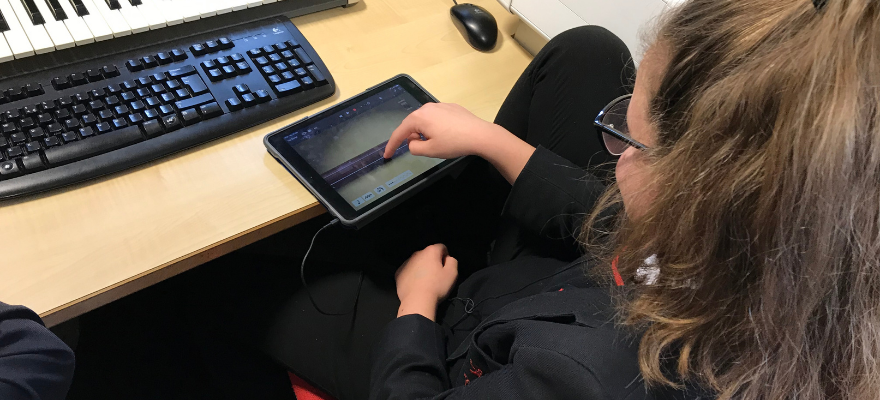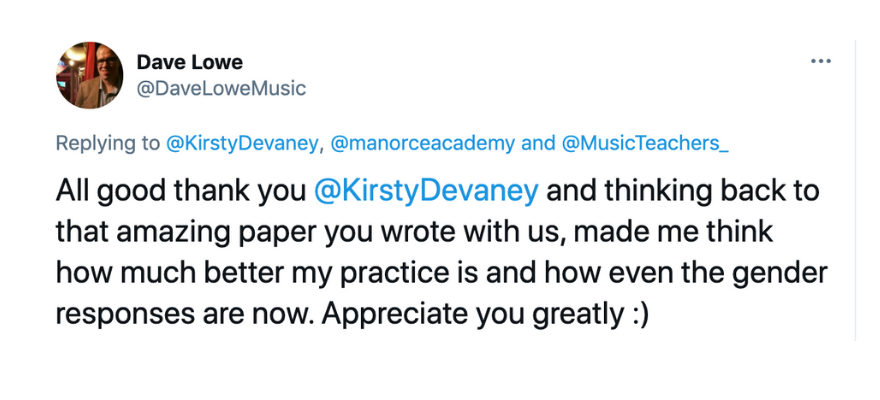
Blog

Although it feels like a lifetime ago now due to Covid-19 restrictions - I used to have the privilege of visiting music teachers and local schools as part of my research assistant role at CSPACE. Sometimes these would be part of a funded research project, but other times they were just to see new and interesting practices, and to hear about some of the challenges and joys of classroom music teaching directly from those living it every day. One of these visits was to Manor Church of England Academy where their inspiring music teacher, Dave Lowe had been developing composing pedagogies using Apple iPads. This blog reflects on this visit now in light of the Covid-19 pandemic.
In 2019 I was invited to Manor CE Academy in York, to see and hear some of the work their music teacher Dave Lowe had been developing with his secondary school music students. When walking into the classroom you could see the usual music classroom set-up; keyboards, instruments in the corner, piano at the front, posters on the wall, desktop computers for composing. The big difference however was that every student had an Apple iPad on their lap. The school had been integrating iPads into school life for about five years by the time I had come to visit, meaning that they were very much viewed as an everyday learning tool.
A creative "buzz"
At lunch time students were invited into the music department to compose music through the iPad software GarageBand. The classroom was full of students from all year groups and there was a lovely "buzz" of excitement and enthusiasm about the department. During the session some students worked together and chatted quietly, whilst others worked carefully on their compositions alone. There was a general sense of calm and control with using the technology, with students offering support to each other, solving problems independently, or asking for help from their teacher when needed. Most students appeared confident enough to "try things out", and "see what happens" without too much fear of failure. Students commonly recorded new layers of music, listened back, and edited it when something didn't sound quite right.
Students seemed motivated by their enjoyment and curiosity rather than any pressure to pass an exam or assessment. This intrinsic motivation, whereby an individual is motivated by ‘their own interest and involvement’ (Amabile, 1985: 393), is said to be better for creativity (Amabile, 1979), compared to extrinsic motivation. This is something I also found in my own PhD research with students having to compose for their GCSE and A level examinations.
The freedom and flexibility, combined with peer support, and teacher and encouragement at Manor CE Academy seemed like the perfect environment for creativity to thrive!

Technology in the music classroom
The use of new technologies in the music classroom is by no means a new phenomena, however it has often been the cause of ongoing debate and contention amongst musicians and music teachers with some believing it to undermine the fundamental concepts of music education (Wise, 2016). However, technology has completely transformed the way we perform and compose music in the professional field (Green, 2002; Savage, 2012) - now even more so due to the current Covid-19 crisis. Musicians who have never needed to engage in music technology, are now having to quickly learn a whole new set of skills.
Technology in the music classroom can allow students to experience more ‘real world’ (Wise et al., 2011) creative practices, that may also be more ‘culturally relevant’ (Gall and Breeze, 2005: 427) and closely linked to the music they play and listen to outside of school - thus bridging the gap between "school music" and the music they experience out of the classroom. The use of music technology has been viewed as more inclusive and ‘egalitarian’ (Folkestad et al., 1998: 83), allowing students without formal instrumental training to engage in the act of composing (Nilsson and Folkestad, 2005; Reynolds, 2005; Kardos, 2012).
Women, girls and technology
Upon speaking to some of the girls in the classroom during my visit, there seemed to be a slight difference in their confidence compared to the boys. Two girls told me that they "weren’t very good with technology", and I watched a year nine student, who had spent a long time inputting a drum pattern, deleted all her her progress just before the end of the lesson. The teacher, who had a lovely manner with all of his students, noticed this and suggested she come back at lunch time for some addition help, thus ensuring she did not get too behind.
These incidents got me thinking about women in music technology and composing more widely. We know that women are still underrepresented in the educational and professional fields both for composition and music technology. But this isn't the case everywhere; Boise (2017) compared the UK to Sweden in terms of undergraduate applications and offers for music technology courses, highlighting the lack of gender equality in the UK. What is turning girls and young women in the UK away from studying composing and music technology?
Boise (2017) argues that music technology has been traditionally viewed as ‘masculine’ (Boise, 2017: 33), with men perceived as ‘expert users’ (Armstrong, 2011: 2), and women as 'less able and less interested' (Armstrong, 2011: 3). One argument is that boys are encouraged to engage with technology more through things like video gaming (Pegley, 2006). Another argument is that the male dominated domains, such as DJing can be unwelcoming for some women (Katz, 2006: 583).

I was curious, and I asked Dave if he had noticed any sense of gender difference in the use of technology. Upon reflection he felt that low confidence was perhaps more prominent with his older female students. He mentioned that the way he introduced Garageband to students was by getting them to think of it like a new games console such as an Xbox or PlayStation. From this he found that the boys would happily start pressing buttons to see what would happened, but often the girls were more reluctant to explore the technology in this way. Dave also found that girls sometimes became more nervous about sharing their finished works, compared to the boys in the class. This gender difference was also found in a recent internal assessment where he reported that the boys, as a whole, had done better than the girls in the class.
Does this lack of confidence in school start to explain the lower numbers of female music technologists? How do we, as music-educators, tackle this gender division?
Future thinking
So much has changed since I was able to visit Manor CE Academy, but it has got me thinking; considering how vital technology has become for all of us, how much is the gender gap also effecting student's ability to learn? The conversations I had with Dave at Manor CE Academy felt like an important reminder to me that as we develop new educational tools that we hope create a more inclusive learning environment, we have to continue to ask; who is it benefiting, and who is it hindering?
I have been following Dave on Twitter throughout this pandemic who has somehow remained smiley and optimistic throughout as he continues to find new methods and ways of engaging his pupils. We had a brief twitter exchange and he reminded me of my visit and our chats, and how it has helped him reflect on, and make changes to his practice, thus ensuring all young people have the opportunity to progress and enjoy creating their own music.

I would like to take Dave and Manor CE Academy for welcoming me and I look forward to being able to visit again soon!
References
- Amabile, T. (1979) 'Effects of external evaluation on artistic creativity', Journal of Personality and Social Psychology, 37(2), pp. 221-233.
- Amabile, T. (1985) 'Motivation and Creativity: Effects of Motivational Orientation on Creative Writers', Journal of Personality and Social Psychology, 48(2), pp. 393-399.
- Armstrong, V. (2011) Technology and the gendering of music education, Farnham, Ashgate.
- Boise, S. (2018) Gender Inequalities and Higher Music Education: Comparing the UK and Sweden. BJME, 35, 1, 23–41
- Devaney, K. (2018) 'How Composing Assessment in English Secondary Examinations Affect Teaching and Learning Practices '. School of Education Vol. Ph.D., Birmingham, UK, Birmingham City University.
- Folkestad, G., Hargreaves, D. J. & Lindström, B. (1998) Compositional Strategies in Computer-Based Music-Making. British Journal of Music Education, 15, 1, 83 - 97.
- Gall, M. & Breeze, N. (2005) Music composition lessons: the multimodal affordances of technology Education review 57, 4, 415-433
- Green, L. (2002) How popular musicians learn: a way ahead for music education, Aldershot, Ashgate.
- Kardos, L. (2012 ) How music technology can make sound and music worlds accessible to student composers in Further Education colleges British Journal of Music Education, 29, 2, 143-151
- Katz, M. (2006) Men, Women, and Turntables Gender and the DJ Battle.pdf. The Musical Quarterly, 89, 4, ol. 89, No. 4 (Winter, 2006), pp. 580-599.
- Nilsson, B. & Folkestad, G. (2005) Children's practice of computer-based composition MUSIC EDUCATION RESEARCH, 7, 1, 21-37.
- Reynolds, N. (2005) The Computer as Scaffold, Tool and Data Collector: Children Composing with Computers. Education and Information Technologies 10, 3, 239–248.
- Savage, J. (2012) 'Those who can, play; those who can’t, use Music Tech?'. In Philpott, C. & Spruce, G. (Eds), Debates in Music Teaching, pp. 169-184. Oxon, Routledge.
- Pegley, K. (2006) "Like Horses to Water": Reconsidering Gender and Technology Within Music Education Discourses. Women & music, 10, 1, 60-70
- Wise, S. (2016) 'Secondary school teachers’ approaches to teaching composition using digital technology', British Journal of Music Education, 21(2), pp. 215– 221.
- Wise, S., Greenwood, J. & Davis, N. (2011) Teachers’ use of digital technology in secondary music education; Perceptions and issues. British Journal of Music Education, 28, 2, 117–134.




